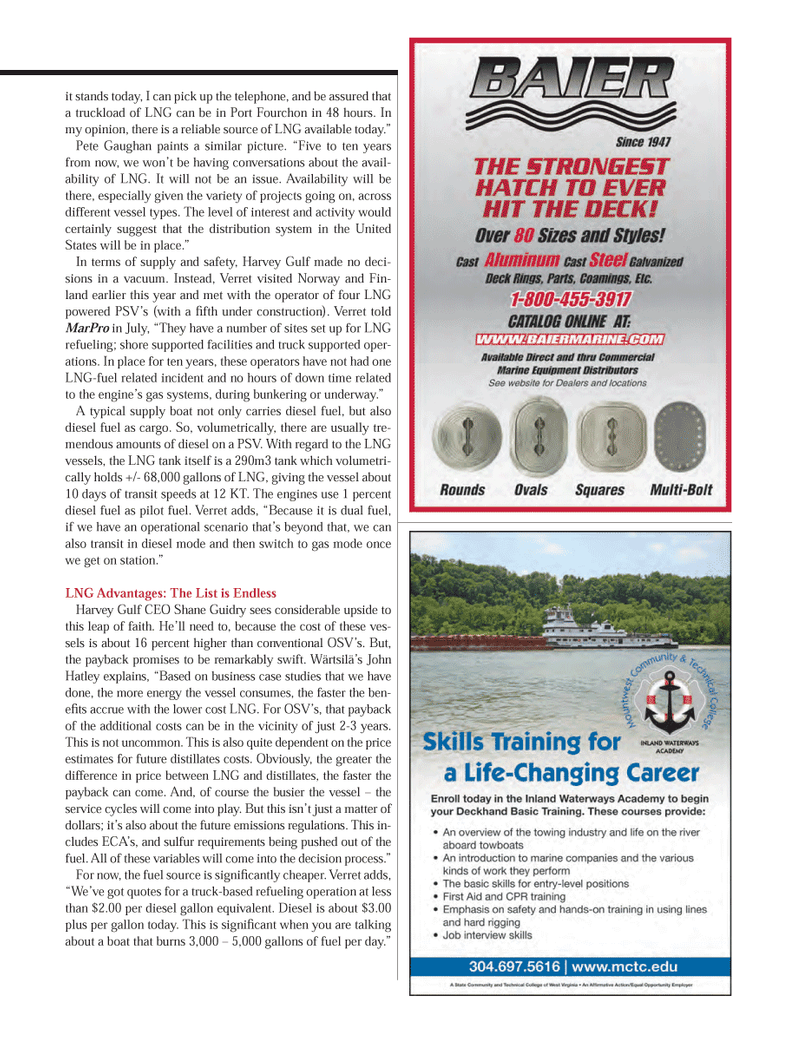
Page 47: of Maritime Logistics Professional Magazine (Q3 2012)
Classification Societies, Quality & Design
Read this page in Pdf, Flash or Html5 edition of Q3 2012 Maritime Logistics Professional Magazine
it stands today, I can pick up the telephone, and be assured that a truckload of LNG can be in Port Fourchon in 48 hours. In my opinion, there is a reliable source of LNG available today.? Pete Gaughan paints a similar picture. ?Five to ten years from now, we won?t be having conversations about the avail- ability of LNG. It will not be an issue. Availability will be there, especially given the variety of projects going on, across different vessel types. The level of interest and activity would certainly suggest that the distribution system in the United States will be in place.? In terms of supply and safety, Harvey Gulf made no deci- sions in a vacuum. Instead, Verret visited Norway and Fin- land earlier this year and met with the operator of four LNG powered PSV?s (with a fth under construction). Verret told MarPro in July, ?They have a number of sites set up for LNG refueling; shore supported facilities and truck supported oper- ations. In place for ten years, these operators have not had one LNG-fuel related incident and no hours of down time related to the engine?s gas systems, during bunkering or underway.? A typical supply boat not only carries diesel fuel, but also diesel fuel as cargo. So, volumetrically, there are usually tre- mendous amounts of diesel on a PSV. With regard to the LNG vessels, the LNG tank itself is a 290m3 tank which volumetri- cally holds +/- 68,000 gallons of LNG, giving the vessel about 10 days of transit speeds at 12 KT. The engines use 1 percent diesel fuel as pilot fuel. Verret adds, ?Because it is dual fuel, if we have an operational scenario that?s beyond that, we can also transit in diesel mode and then switch to gas mode once we get on station.? LNG Advantages: The List is Endless Harvey Gulf CEO Shane Guidry sees considerable upside to this leap of faith. He?ll need to, because the cost of these ves- sels is about 16 percent higher than conventional OSV?s. But, the payback promises to be remarkably swift. Wärtsilä?s John Hatley explains, ?Based on business case studies that we have done, the more energy the vessel consumes, the faster the ben- e ts accrue with the lower cost LNG. For OSV?s, that payback of the additional costs can be in the vicinity of just 2-3 years. This is not uncommon. This is also quite dependent on the price estimates for future distillates costs. Obviously, the greater the difference in price between LNG and distillates, the faster the payback can come. And, of course the busier the vessel ? the service cycles will come into play. But this isn?t just a matter of dollars; it?s also about the future emissions regulations. This in- cludes ECA?s, and sulfur requirements being pushed out of the fuel. All of these variables will come into the decision process.? For now, the fuel source is signi cantly cheaper. Verret adds, ?We?ve got quotes for a truck-based refueling operation at less than $2.00 per diesel gallon equivalent. Diesel is about $3.00 plus per gallon today. This is signi cant when you are talking about a boat that burns 3,000 ? 5,000 gallons of fuel per day.?

 46
46

 48
48
